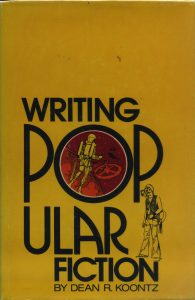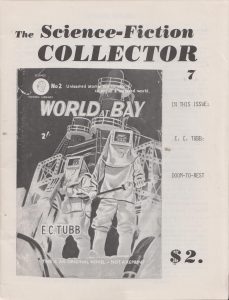Writing Popular Fiction
See Also: Dean Koontz Writes
Trade Hardcover

Notes
Acknowledgments: “Legacy of Terror, Demon Child are copyright 1971 by Deanna Dwyer and are quoted by permission of the author. The Haunted Earth is copyright 1973 by Dean R. Koontz. The appearance of the original sample chapter and outline, from which it was sold, is by permission of Lancer Books.”
p9: “…in my own novel Chase (under the pseudonym K. R. Dwyer)…”
p13: “One of my own, Blood Risk (under the pseudonym Brian Coffey)…”
p77: “In the first book of a suspense series I have just begun for Bobbs-Merrill Blood Risk by Brian Coffey…”
p116-117 Chapter 5: Gothic-Romance
Briefly discusses writing two gothic romances with a “female by-line”. Koontz then goes on to quote from Deanna Dwyer without acknowledging it was he. He also claims that three Deanna Dwyer books are “yet to be published”.
p139: “Generally speaking, there are two kinds of erotic novels: the Sexy Novel and the Rough Sexy Novel. You can make a fortune on the first and little more than pocket money on the last. Big Sexy Novels are written by Harold Robbins, Jacqueline Susann, Henry Sutton, Morton Cooper, Rona Jaffe, and many others. Six figure incomes are a starting place in the Big Sexy Novel field, with million dollar rewards if you achieve the position of a Robbins or a Susann. Rough Sexy Novels are written by, among hundreds of others, Marcus Van Heller, Ann Griffin, Tor Kung, Peggy Swenson, Marco Vassi, and Jesse Taylor. Their financial rewards average between $1,000 and $3,000 a book, and they do not even receive the fringe benefits of national fame accorded the BigSN writer-to say nothing of the subsidiary rights a RoughSN novelist rarely ever profits from.”
Marcus Van Heller is a pseudonym of John Stevenson
Tor Kung is a pseudonym of Jack Gilbert & Jean Maclean
Peggy Swenson is a pseudonym of Richard E. Geis
Marco Vassi (not a pseudonym)
Jesse Taylor (unknown)
p148: “None of these, however, would be appropriate titles for the RoughSN, which must come on much more forcefully, as these several examples attest: Share the Warm Flesh, Thirteen and Ready!, Swapper’s Convention, Sextet, Thrust, and Hung!.
“The old pornographers” by Alez Nevala-Lee
February 9, 2015
“[John] Cleve [a pseudonym of Andrew Offutt] plunged into the world of paperback pornography and never left, but other writers in the middle third of the last century used it as a kind of paid apprenticeship, cranking out an anonymous novel a month, learning a few useful tricks, and moving on once they had established a name for themselves in other genres. And they included Dean Koontz, Lawrence Block, Donald E. Westlake, and Anne Rice, as well as undoubtedly many more who haven’t acknowledged their work in public.
“…But it’s hard not to feel at least a little nostalgic for a time when it was possible for writers to literally prostitute their talent, while hopefully emerging with some valuable experience. In Writing Popular Fiction, which dates from around the same period, Koontz outlines a few of the potential benefits: …”
Alec Nevala-Lee interviews science fiction author Barry N. Malzberg
June 21, 2021
0:37:09
Nevala-Lee: At this point where you spending time or, you know, interacting with other writers?
Malzberg: Oh yeah.
Nevala-Lee: What were some of the writers you knew best?
Malzberg: The writers I knew best? Oh, Dean Koontz early in his career? Who is an agency client? [Bill] Pronzini, of course, with whom, I, we broke five novels together. Silverberg, of course. A lot of people. Varying degrees of acquaintances. Koontz and I, Pronzini and I, knew each other very well. They were very close friendships. Silverberg was miles ahead of me as a writer. But in Michael Swanwick’s words about about his own relationship with Silverberg, from the beginning [unintelligable] a human being. And we embarked upon in the early, the mid seventies upon a correspondence, which lasted 20 years. And he’s extraordinary.
Nevala-Lee: I wonder if you could talk a bit about Dean Koontz because I don’t think a lot of people realized that he had such a prolific career in science fiction. And, you know, mystery and other genres before he really broke through with novels for which he’s best known.
Malzberg: Yes, he did. Yes, he did and I was there to see all of it. He wanted to be a sicence ficiton writer by his own words in the early, in the early, the mids ’70s and he had published by that time several novels. He said I just realized, you know, it it wasn’t what, it wasn’t where I, what I wanted it to be or where I could go, so I had to go elsewhere. I want to interject, that Demon Seed that it became a movie as you may know. It was adapted from for a big deal movie but it was a novel and that and the other Bantam Novel The Flesh in the Furnace were written when he essentially given up [on Science Fiction], he had closed the doors and, and through mystery and suspense, was working his way out of it. But he was a very good science fiction writer. Better than he thought himself to be, and could have had a major career. And we know what happens to people who [unintellgiible] major careers in science fiction. So he was smart.
Nevala-Lee: One of the first books I ever read about writing was a book called Writing Popular Fiction, which…
Malzberg: Yeah I remeber that.
Nevala-Lee: …which Koontz wrote probably when he was in his late twenties and I still have copy.
Malzberg: He also wrote for Writer’s Digest Press, How to Write a Bestseller. [How To Write Best Selling Ficiton] Which I found amusing because at the time the book was published. He had not written a bestseller. He [eventually] did as we know.
Nevala-Lee: Yeah, the first book though is one that I basically memorized. I read him a lot growing up and I still think about some of the rules that he laid down for writing science fiction in particular.
Malzberg: Yeah. Yeah. He was quite sensible. There is, I agree with Vonnegut, writing cannot be taught, it can be learned, but it cannot be taught, but stipulating that, Koontz’s books were as good as any. No question.
0:40:36
According to Dean:
“When the editor requested that I add two genres to the book—erotica and westerns—the publisher was agreeable to having [redacted] ghost both chapters, since as both an editor and a writer, he had more experience of these markets than I did.”
–Letter to the Author
Ephemera:
 Listed as an item for sale by publisher J. Grant Thiessen in issue #7 of The Science-Fiction Collector, July 1979, p47.
Listed as an item for sale by publisher J. Grant Thiessen in issue #7 of The Science-Fiction Collector, July 1979, p47.
Last updated on February 28th, 2018
